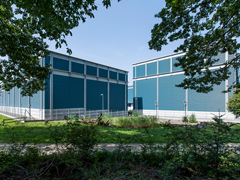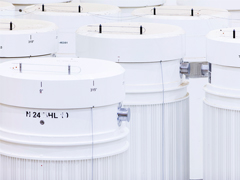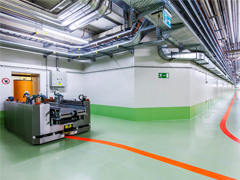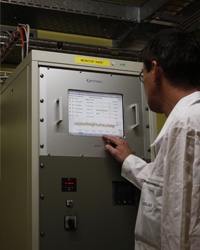Safety is given top priority
Construction measures
When the facility was planned, safety considerations took into account even rare occurrences, such as severe earthquakes. Thanks to extensive safety precautions, there is no conceivable emergency that could occur inside the plant which could pose a risk to the public beyond its perimeters.

Environmental compatibility
During the multi-level nuclear approval procedure, the conventional impact of the project on the environment was assessed in a two-level environmental impact report in compliance with the environmental legislation in force at the time. The actual state of the air and climate, noise, groundwater, surface waterbodies, soil, flora and and fauna, forests and landscape was assessed and the effects of operating the facility were identified. The modern waste treatment facilities of Zwilag were a clear improvement on earlier conditioning and incineration plants.
Airplane crash
The risk of an airplane crashing on the Zwilag site was also taken into account when the plant’s safety was considered. All types of airplane that could cause considerable damage and trigger a radiation risk to the population were included in the assessment. These are civil aviation airplanes as well as the jet airplanes flown by the military. In spite of the fact that such a risk was shown to have a very small probability of occurrence, the unlikely possibility of an airplane crash was taken into account in the safety planning. Its impact was calculated in the hazard incident analysis and measures to limit the damage were implemented.

Cask supervision
Both the highly radioactive vitrified waste and the spent fuel rods are put into massive steel casks weighing up to 140 tonnes for interim storing. These casks are also used as transport containers. The casks protect the waste and fuel rods from all conceivable hazards such as airplane crashes, earthquakes, fire and other incidents. Only casks types licenced by the authorities are used. The casks in interim storage are continuously monitored. The storage halls are also continuously checked for radioactivity.

Safety during transport of radioactive materials
Radioactive waste and spent fuel rods are transported to the central interim storage facility by train and truck. Worldwide, experience has been gathered by transporting waste over many millions of kilometres. In Europe alone, thousands of transports of spent fuel rods were carried out without a single incident involving the release of the radioactive contents of a container. Transports of radioactive materials are internationally regulated and are subject to multiple controls. A permit must be obtained for every single transport.
Casks for high-level vitrified waste and spent fuel rods are subjected to tests where the containers have to withstand a drop of nine metres onto a hard surface as well as a fire exposure test with an average flame temperature of at least 800° C. The waste is compacted in a manner that guarantees the inclusion of all radioactive elements. There is no risk to people and the environment, even during transport.

Continuous safety checks
The interplay between man and machine is continuously optimised in order to improve safety levels. Zwilag exchanges knowledge and experience with similar plants in other countries so that everybody involved can learn from the mistakes that are made. Safety with regard to the operation of the plant, machines and electrical installations and the monitoring operations also means that the facilities must be continuously updated and brought into line with the latest technical standards. Several million francs are invested in expansion and renovation work every year. The central interim storage facility is therefore a modern plant operated by expertly trained staff who are reliable not only in safety issues, but in every regard.
